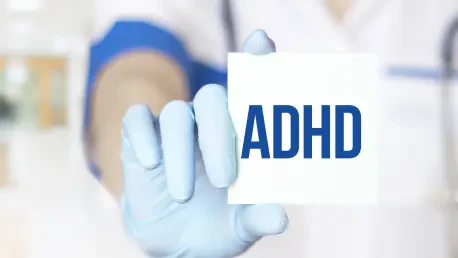In England, the landscape of ADHD diagnoses and prescriptions has markedly shifted, reflecting growing awareness and changing societal attitudes toward the condition. Over the decade, ADHD diagnoses have surged as individuals and healthcare systems increasingly recognize the symptoms of this neurodevelopmental disorder. Recent data unveils that 2024/2025 witnessed a substantial increase in adult prescriptions by 24.3% compared to the previous year, pointing toward an amplified demand for central nervous system stimulants. Furthermore, a rise in children’s prescriptions by 9.5% aligns with these figures. This trend reveals deeper societal shifts in the perception of ADHD, encouraging dialogue about its implications on public health and well-being.
Factors Behind the Surge
Growing Recognition and Awareness
The rise in ADHD prescriptions in England coincides with a growing recognition of the condition’s prevalence among diverse demographics, particularly women. Data from NHS Business Services Authority Digital highlights an increase in female representation among ADHD patients from 24% to 38% over ten years. This notable change reflects better awareness and understanding of ADHD, especially in women, who were historically underdiagnosed. Contributing to the shift is an increasing societal conversation around neurodiversity, which empowers individuals to seek diagnosis and treatment. This dialogue has resulted in enhanced information access, allowing people to better identify symptoms and pursue healthcare support. Pharmacists and healthcare providers have also played integral roles in advancing neurodiversity discussions, advocating for patient-centered approaches and thorough diagnostic evaluations.
Shortages and Challenges
Despite the positive trends in recognition and awareness, persistent ADHD medication shortages have posed challenges in the UK since 2022. Global demand and manufacturing difficulties have constrained the availability of these essential medications, leading to concerns among pharmacists about potential risks for patients unable to access their prescriptions. These shortages underline the need for robust systems to manage supply and demand to ensure patients receive continuous care. Addressing shortages requires collaborative efforts between pharmaceutical companies, healthcare providers, and policymakers focused on sustainable solutions that prioritize patient access and medication safety. Pharmacists like Khadija Mansoorali emphasize their role in guiding patients through these challenges, providing personalized care and ensuring that neuro-affirmative language frames patient interactions, thereby maximizing understanding and compliance.
Impacts and Opportunities for Systemic Change
Advancing Diagnosis and Patient Impact
Henry Shelford of ADHD UK views the rise in diagnoses as transformative, offering individuals new opportunities to improve their quality of life and career prospects. A formal diagnosis not only validates personal experiences but also opens up educational and professional pathways that might have been hindered by unmanaged symptoms. Shelford advocates for systemic reforms in the recognition and assessment of ADHD, crucial for addressing gaps in current approaches and enhancing accessibility to treatment services. By implementing comprehensive protocols for ADHD diagnosis, healthcare systems can align their services to meet the needs of individuals, fostering environments where neurodiversity is embraced rather than stigmatized. These reforms may pave the way for more inclusive educational and workplace settings, ultimately contributing to an equitable society where ADHD is understood and managed effectively.
Pharmacists’ Role in Medication Management
As critical healthcare providers, pharmacists are positioned to address medication shortages and offer safe guidance to patients amidst these challenges. Their expertise can help mitigate supply-chain disruptions by optimizing prescription fulfillment processes and advising individuals on alternative treatments where necessary. Pharmacists are also instrumental in advocating for neurodiversity, focusing on personalized care that respects each patient’s unique circumstances and preferences. By fostering patient-pharmacist relationships rooted in trust and understanding, they enhance overall medication adherence and treatment effectiveness. Through continuous professional education and collaborative efforts, pharmacists can ensure that patients not only receive essential medications but also experience comprehensive, compassionate care that acknowledges their neurodevelopmental needs.
Broadening Implications and Future Directions
The surge in ADHD prescriptions highlights broader trends across pharmaceutical sectors, which have seen rising demands for other medications, including antidepressants and treatments for dementia. Since 2023/2024, antidepressant prescriptions have climbed by 1.6%, and dementia-related prescriptions have increased by 5.4%. These statistics indicate growing healthcare needs that signal potential changes in patient demographics and treatment approaches. Addressing these demands necessitates strategic partnerships among healthcare providers, policymakers, and payers to ensure equitable access to medications across conditions. The future of ADHD treatment and its integration into broader healthcare systems relies on sustainable practices that accommodate diverse patient needs. These considerations drive conversations that inform policies and innovations targeted at evolving patient-centric models that improve mental health outcomes and overall quality of life.
Evolving Perspectives and Next Steps
In England, there has been a significant shift in the diagnosis and prescription landscape for ADHD, reflecting increased awareness and evolving societal attitudes toward this condition. Over the past decade, diagnoses of ADHD have surged as more individuals and healthcare providers recognize the symptoms associated with this neurodevelopmental disorder. Recent statistics highlight a remarkable increase in adult prescriptions by 24.3% during 2024/2025 compared to the previous year, suggesting a heightened demand for central nervous system stimulants. Concurrently, children’s prescriptions have risen by 9.5%, mirroring these numbers. This trend reveals deeper societal transformations in how ADHD is perceived, sparking discussions about its broader implications on public health and overall well-being. These shifts in recognition and treatment underscore the need for continued dialogue about ADHD’s impact on society, promoting a more comprehensive understanding and effective responses to this significant health concern.









